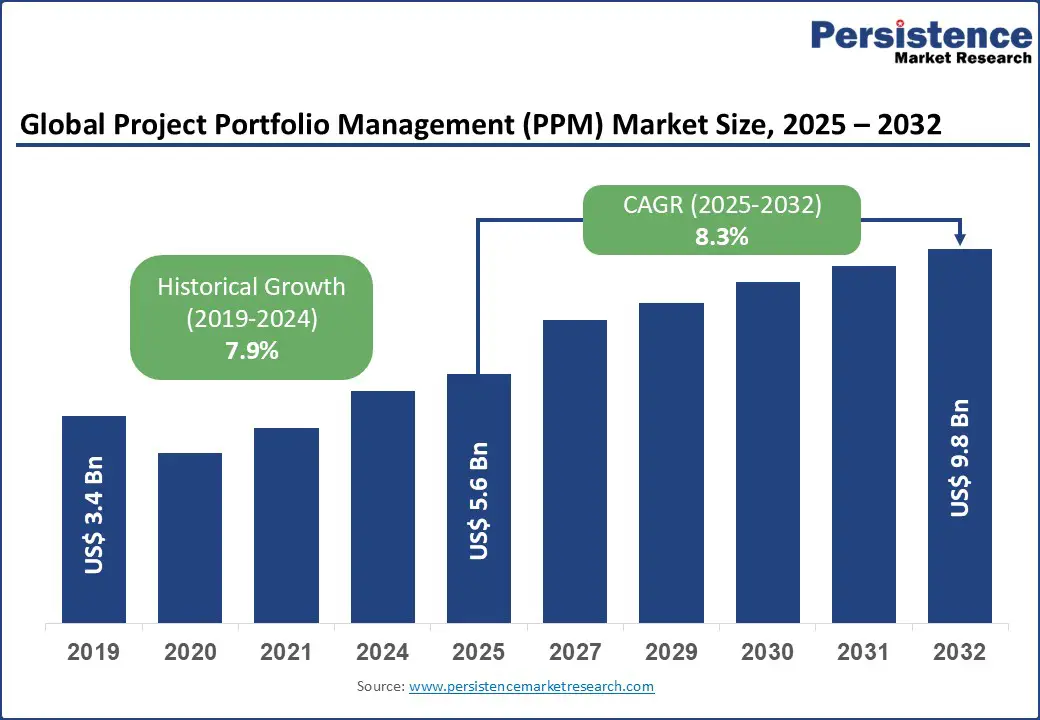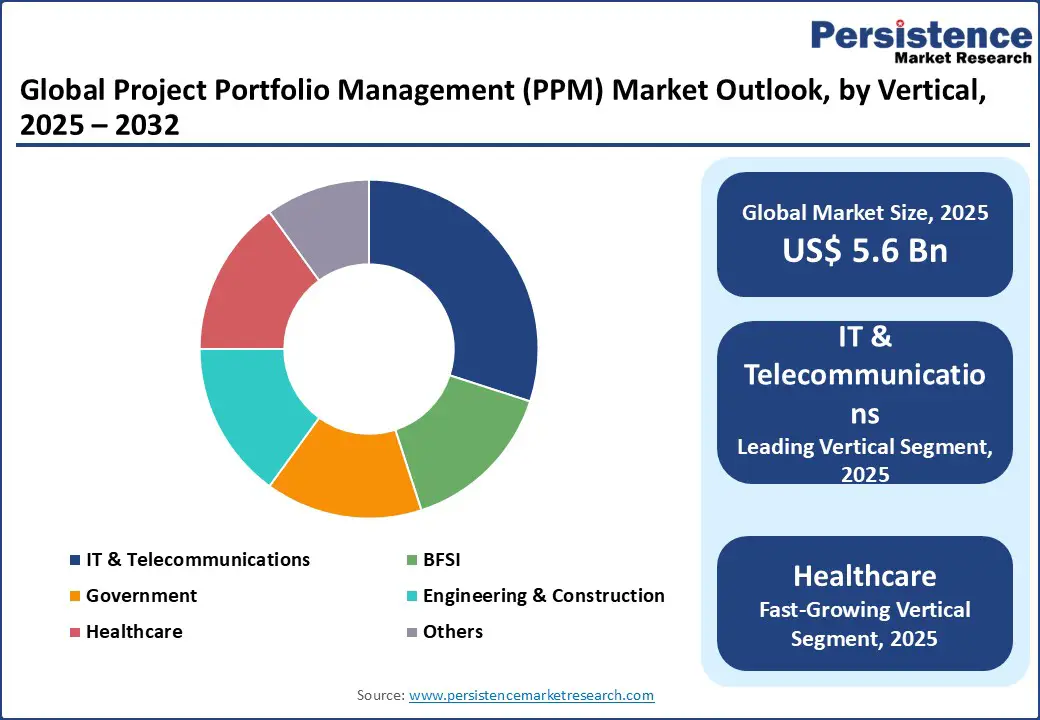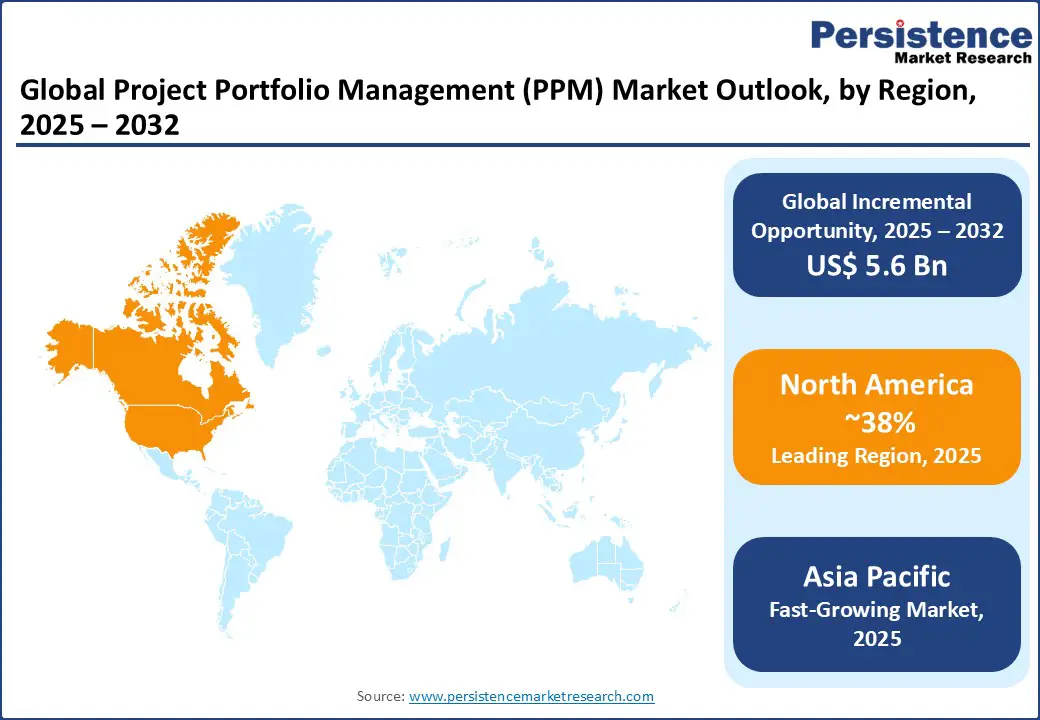ID: PMRREP10637| 189 Pages | 23 Sep 2025 | Format: PDF, Excel, PPT* | IT and Telecommunication

The global project portfolio management (PPM) market size is likely to be valued at US$ 5.6 Bn in 2025 and estimated to reach US$ 9.8 Bn by 2032, registering a CAGR of 8.3% during the forecast period from 2025 to 2032, driven by the increasing demand for efficient resource allocation, strategic project alignment, and enhanced decision-making in complex, multi-project environments. PPM solutions, encompassing software and services for project governance, analytics, and resource management, enable organizations to optimize project execution and achieve business objectives.
Key Industry Highlights:

| Key Insights | Details |
|---|---|
|
Project Portfolio Management Market Size (2025E) |
US$ 5.6 Bn |
|
Market Value Forecast (2032F) |
US$ 9.8 Bn |
|
Projected Growth (CAGR 2025 to 2032) |
8.3% |
|
Historical Market Growth (CAGR 2019 to 2024) |
7.9% |
The global push for digital transformation has transformed project management, with organizations adopting cloud-based PPM solutions to support remote work, scalability, and real-time collaboration. Industries such as healthcare and government are leveraging PPM to manage digital transformation initiatives, such as implementing electronic health records and smart city projects. Cloud platforms enable seamless integration with enterprise systems such as ERP and CRM, allowing organizations to unify data and streamline operations. The flexibility of cloud-based PPM solutions supports agile methodologies, enabling teams to adapt to changing project requirements.
In regions such as the Asia Pacific, where digital infrastructure is rapidly expanding, companies are adopting cloud PPM to manage large-scale technology deployments, ensuring cost-efficiency and operational agility. The ability to access PPM tools remotely has also become critical in hybrid work environments, driving widespread adoption across enterprises seeking to modernize their project management practices.
Implementing PPM solutions, particularly for large enterprises, involves significant financial and operational challenges. The costs of software licenses, integration with existing systems, and ongoing maintenance can be prohibitive for SMEs, which often lack the budget and expertise to deploy complex PPM platforms. Large-scale implementations require extensive customization to align with organizational workflows, leading to prolonged deployment timelines and increased expenses. Additionally, the lack of skilled PPM professionals creates a bottleneck, as organizations struggle to train staff or hire experts proficient in advanced PPM tools. The complexity of integrating PPM with legacy systems, particularly in industries such as manufacturing, also poses challenges, as organizations must overhaul existing processes to achieve full functionality, deterring smaller players from entering the market.
The shift to cloud-based PPM solutions offers significant growth potential, driven by their scalability, cost-efficiency, and support for remote collaboration. Cloud platforms enable organizations to access PPM tools without significant upfront investments in infrastructure, making them accessible to SMEs and large enterprises alike. The flexibility of cloud-based PPM supports agile project management, allowing teams to adapt to changing requirements in real-time. In sectors such as government and BFSI, where data security and compliance are critical, cloud PPM solutions with robust encryption and access controls are gaining traction.
The ability to integrate cloud PPM with other enterprise tools, such as Microsoft Teams or Salesforce, enhances operational efficiency and collaboration. As organizations worldwide prioritize digital transformation, the demand for cloud-based PPM is expected to create substantial market opportunities, particularly in emerging economies with expanding digital infrastructure.
Software dominates the project portfolio management (PPM) market, holding a 65% share in 2025. The segment’s leadership is driven by the scalability, advanced analytics, and integration capabilities of PPM software, which cater to the needs of complex project environments. Solutions such as Oracle’s Primavera, Microsoft’s Project, and SAP PPM provide robust features for project governance, resource management, and real-time analytics, making them essential for large enterprises. The ability to integrate with ERP, CRM, and analytics platforms enhances their appeal, enabling organizations to streamline operations and align projects with strategic goals.
Services is the fastest-growing segment, driven by the increasing demand for integration, training, and support to ensure successful PPM implementation. Services such as consulting and deployment help organizations customize PPM solutions to their specific needs, particularly in industries with complex workflows such as BFSI and engineering. The growing complexity of projects and the need for ongoing maintenance drive demand for specialized services, as organizations seek expert guidance to maximize the value of their PPM investments.
Cloud-based deployment is poised for a significant share of 60% in 2025, due to its flexibility, scalability, and lower upfront costs. Cloud platforms such as Planview’s Enterprise One and Atlassian’s Jira Align enable remote access and collaboration, supporting hybrid work environments. Their ability to integrate with enterprise systems and provide real-time updates makes them ideal for industries such as IT and government, where agility and visibility are critical.
Hosted deployment is the fastest-growing segment, driven by its hybrid approach combining on-premise control with cloud accessibility. Hosted PPM solutions appeal to organizations with data sovereignty concerns, such as government agencies in Europe, where secure environments are prioritized. The flexibility of hosted deployments supports industries requiring tailored solutions, enhancing adoption in complex project settings.
Project & portfolio governance leads the application segment, accounting for 35% of market revenue in 2025. The segment’s dominance is driven by the need for strategic alignment and compliance in industries such as BFSI and government, where regulatory oversight is critical. Governance tools ensure projects align with organizational objectives, mitigate risks, and meet compliance requirements, making them essential for large-scale initiatives.
Portfolio dashboards & analytics are the fastest-growing applications, fueled by the demand for real-time insights and data-driven decision-making. Dashboards provide visibility into project performance, enabling executives to prioritize high-value initiatives and optimize resource allocation. The integration of AI-driven analytics enhances forecasting accuracy, driving adoption in IT and healthcare sectors.
IT & Telecommunications dominates the vertical segment, holding a 30% share in 2025, driven by the complexity of managing large-scale, technology-driven projects. PPM solutions support agile methodologies and digital transformation, enabling IT firms to manage multiple projects efficiently and align with market demands.
Healthcare is the fastest-growing vertical, driven by increasing regulatory compliance and digital health initiatives. PPM tools support the management of complex projects, such as electronic health record implementations, ensuring compliance with regulations such as HIPAA and improving project outcomes in healthcare organizations.

North America dominates the project portfolio management market, accounting for a 38% share in 2025, driven by its advanced IT infrastructure, mature project management practices, and stringent regulatory frameworks. The U.S. leads the region, with significant investments in digital transformation across IT, BFSI, and government sectors. Large enterprises in the U.S. adopt PPM solutions to manage complex project portfolios, driven by the need for compliance with regulations such as the Sarbanes-Oxley Act, which mandates financial transparency.
The region’s leadership is supported by the presence of key players such as Oracle, Microsoft, and ServiceNow, who offer advanced PPM platforms with AI-driven analytics and cloud capabilities. Canada’s focus on digital government initiatives, such as smart city projects, drives demand for PPM tools to ensure efficient resource allocation and project governance. The region’s strong emphasis on innovation, with widespread adoption of cloud-based PPM and agile methodologies, positions North America as a market leader, with enterprises prioritizing data-driven decision-making and operational efficiency.
Europe is poised for a 30% share in 2025, led by Germany, France, and the U.K., driven by robust regulatory frameworks and digitalization efforts. Germany’s Industry 4.0 initiative promotes advanced manufacturing and technology projects, driving demand for PPM solutions to manage complex engineering and IT portfolios. France’s focus on smart city projects and government digitalization fuels the adoption of cloud-based PPM platforms, enabling efficient resource management and project tracking.
The EU’s Digital Compass initiative, aiming for widespread digital adoption, supports PPM growth by encouraging organizations to adopt tools for strategic project alignment. The region’s emphasis on sustainability and compliance, particularly in BFSI and government sectors, drives demand for governance and analytics tools, with companies such as Hexagon AB and SAP SE leading the market. Europe’s mature project management culture and investments in innovation position it as a key market for PPM adoption.
Asia Pacific is the fastest-growing region, with a 25% share in 2025, driven by rapid digitalization, expanding IT infrastructure, and government-led initiatives. China leads the region, with its digital economy fueling demand for PPM solutions to manage large-scale technology and infrastructure projects. India’s Digital India program promotes digital transformation in BFSI, healthcare, and government, driving adoption of cloud-based PPM tools for agile project management.
Japan’s focus on smart cities and South Korea’s investments in 5G and IoT projects further accelerate demand, with PPM solutions supporting complex, technology-driven initiatives. The region’s rapid economic growth and increasing project complexity create opportunities for PPM vendors such as Microsoft and Planview, as organizations prioritize efficiency and data-driven decision-making.

The global project portfolio management market is highly competitive, with Oracle Corporation, Microsoft Corporation, SAP SE, Adobe (Workfront), Hewlett Packard Enterprise Development LP, Broadcom Inc., ServiceNow, Hexagon AB, Atlassian, and Planview, Inc. collectively holding over 70% of the market share. These companies dominate through their robust PPM platforms, which offer advanced analytics, cloud capabilities, and seamless integration with enterprise systems. Oracle’s Primavera suite is widely adopted in engineering and IT for its comprehensive governance and resource management features.
Microsoft Corporation’s Project for the Web and Power BI integration lead in providing scalable, cloud-based solutions for agile project management. SAP SE excels in integrating PPM with ERP systems, catering to the BFSI and manufacturing sectors. Adobe Workfront and ServiceNow focus on user-friendly interfaces and AI-driven analytics, appealing to IT and healthcare industries. Smaller players such as Planview and Atlassian, with Jira Align, gain traction among SMEs and agile-focused firms, offering flexible, cloud-native solutions tailored to dynamic project environments.
The global project portfolio management (PPM) market is projected to reach US$ 5.6 Bn in 2025.
Increasing project complexity, digital transformation, and demand for data-driven decisions drive market growth.
The PPM market is expected to grow at a CAGR of 8.3% from 2025 to 2032.
AI and ML integration and cloud-based PPM solutions offer significant growth potential.
Oracle Corporation, Microsoft Corporation, SAP SE, ServiceNow, and Atlassian are among the key players.
| Report Attribute | Details |
|---|---|
|
Historical Data/Actuals |
2019 – 2024 |
|
Forecast Period |
2025 – 2032 |
|
Market Analysis |
Value: US$ Bn, Volume: As Applicable |
|
Geographical Coverage |
|
|
Segmental Coverage |
|
|
Competitive Analysis |
|
|
Report Highlights |
|
By Component
By Deployment
By Application
By Vertical
By Region
Delivery Timelines
For more information on this report and its delivery timelines please get in touch with our sales team.
About Author